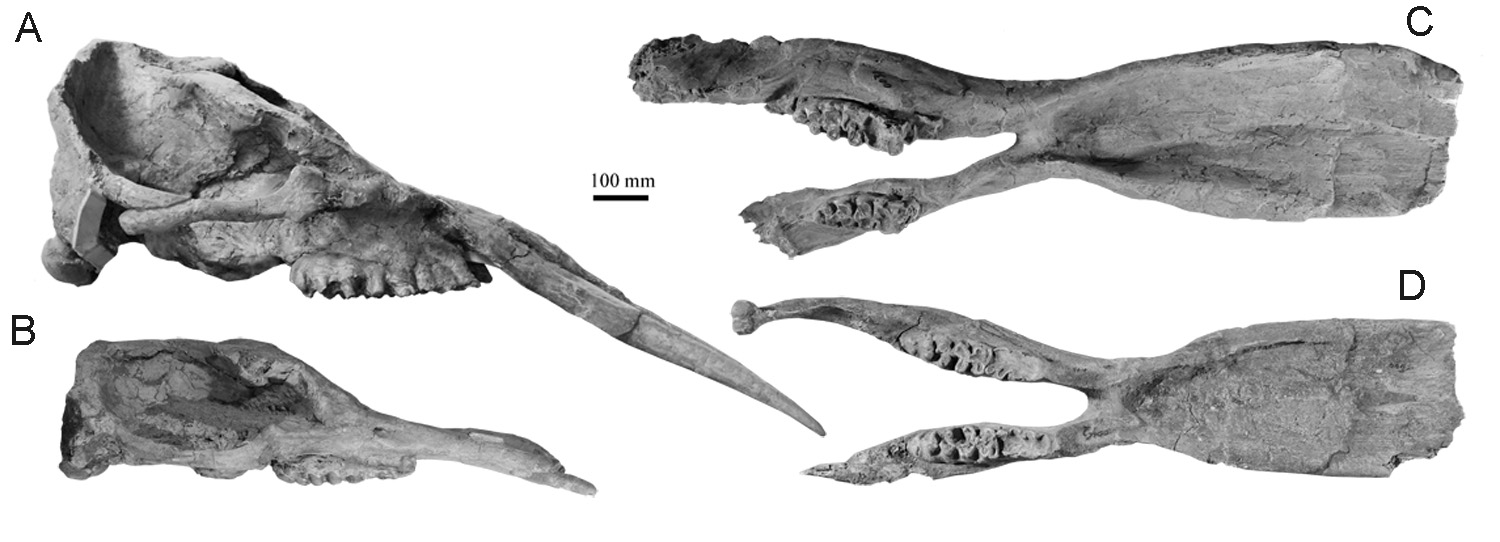New advance on Platybelodon from the Linxia Basin of China
Platybelodon is a group of extinct Proboscidea. They extended from the early Miocene to middle Miocene of Eurasia. Evident also shows that some of them reached
During recent 20 years, researchers from Institute of Vertebrate Paleontology and Paleoanthropology, Chinese Academy of Sciences (IVPP) and Hezheng Paleozoological Museum (HPM) found much material of Platybelodon. The quantity and completeness of the specimens surpass those from the Tunggur Area, including more than 60 nearly complete skulls and mandibles, hundreds of isolated teeth, and a number of post-cranial bones. All of these specimens are housed in the HPM. Recently, Wang ShiQi from IVPP and co-authors from HPM studied the material and published on the Acta Palaeontologica Polonica (Vol. 58, No. 2).
Most of the fossils were discovered from two sites of late middle Miocene Hujialiang Fm., Zengjia and Laogou. The material resembles the type and other material of Platybelodon grangeri from the Zone I of the Tunggur Area in: the portion of the length to width of the mandibular symphysis, the loph(id) number of the cheek teeth, the complexity of the crown pattern, and the heaviness of cementum. Thus the material from Zengjia and Laogou were attributed to the same species as P. grangeri. The skulls from the Zengjia site show strong sexual dimorph. Adult males, except having stronger upper tusks, generally possess higher arched neurocranium and more posteriorly positioned nasal bones than adult females. The adult mandibles are also able to divide into two types: one with relatively narrow and long symphysis and the other with short and broad one. They are determined as male and female, respectively. It seems that the characters of males are more derived than that of females, and the juveniles is more similar to females than males. Furthermore, cheek teeth from the Laogou site is slightly more derived than that from the Zengjia site. Additionally, besides from the late middle Miocene Hujialiang Fm., Platybelodon were also discovered from the early middle Miocene Dongxiang Fm. The teeth is relatively simple, and the transverse symphyseal ledged is absent on the madibular symphysis. The morphology resembles to the type species Platybelodon danovi from the Kuban Region, Caucasus Area, and thus be attributed to this species.
The evolutionary relationships of known Platybelodon were also discussed. The earliest Platybelodon is P. dangheensis from the early Miocene of Danghe, China, following by middle Miocene P. danovi from Caucasus, then by P. danovi from the Linxia Basin, by P. danovi from Tongxin, by P. grangeri from the Junggar Basin, by P. grangeri from the Zone I from Tunggur, by P. grangeri from the Zengjia site of the Linxia Basin, by P. grangeri from Zhongning, by P. grangeri from the Laogou site of the Linxia Basin, and finally by P. grangeri from the Zone II from Tunggur. They constitute a continuously evolutionary series in principle. In this sequence, the loph(id) number of m3 and M3 increased and some individuals from the Zone II from Tunggur even had tetralophodont m2 and M2. The complexity of crown pattern and the heaviness of the cementum of the cheek teeth rose. However, by the end of the middle Miocene, the thrived group was suddenly extinct in
This work was supported by the Strategic Priority Research Program of the

Download attachments: